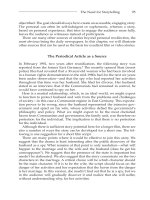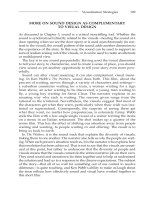Writing the short film 3th - Part 12
Bạn đang xem bản rút gọn của tài liệu. Xem và tải ngay bản đầy đủ của tài liệu tại đây (151.13 KB, 7 trang )
At this point, Gittes is handed a summons and complaint
by the gray-haired man, who remarks that he supposes
they’ll be hearing from Gittes’ attorney. He speaks
pleasantly—just a lawyer doing his job. Then Evelyn
walks out the door, and the scene ends with Gittes
staring down at the thick sheaf of papers.
Gittes quickly modifies his usual rowdy voice to the more genteel one he
uses with female clients as soon as he speaks to the young woman. When she
threatens him with publicity, he reverts somewhat to his usual way of speak-
ing, only because he is in shock. (“It’s not going to do any good to get tough
with me—”) Evelyn Mulwray’s voice is that of a well-educated, wealthy,
quite imperious young woman who appears to be accustomed to getting her
own way. These two are worlds apart.
When you are not familiar with the way a character would speak, it is
often necessary to do research the way that actors and professional
scriptwriters do: take yourself off to the kind of place in which such a per-
son might spend time and listen carefully to conversation around you. In the
short script The Lady in Waiting, the authentic-sounding and very different
voices of Scarlet and Miss Peach are the result of considerable such research
on the writer’s part.
However, we all have many voices available to us—the voices of family
members, of friends, of the people with whom we’ve gone to school, or
played, or worked. Accessing this material is often a first step in discovering
how to write dialogue that works.
EXERCISE 9: AN INTERVIEW
You are going to conduct a friendly, imaginary interview with someone you
know, or have known, well enough to have a good idea of how the person
usually spends a day off. For obvious reasons, don’t choose anyone you live
with or are involved with, or anyone who would be uncomfortable being
interviewed by you. Close your eyes and imagine this person in the room in
which he or she would be most at ease talking to you. In your mind, explain
that the interview is just a writing exercise in which the person will be
anonymous (as they should be).
You will be given a single (apparently) innocuous question to start off your
interview, with a second question as backup in case the person falls silent for
longer than, say, ten seconds. Anything less than that qualifies as a pause.
Pauses, as well as any ahs, hmms, ums, smiles, laughter, or physical actions,
should always be noted: these can often be more revealing than speech.
Remember that your purpose in doing this exercise is to hear the intervie-
wee out, not to control the way in which the interview shapes itself. Try to
Writing an Original Short Screenplay 67
Ch06.qxd 9/27/04 6:05 PM Page 67
avoid interrupting by responding to what is being said; respond only with
encouraging murmurs rather than talk—uh-huh, mmm, right, etc. If things
falter, ask the backup question, which may well lead to a sudden flow of
speech. If you are skeptical, think of all the voices running through your head
on any given day; think of the way in which actors work to create a charac-
ter; think of the way you talked to yourself as a child. Then put aside your
skepticism and go to work.
Here, then, is the first question: How do you spend your day off? (Or, how do
you spend your Sunday?)
The backup question: If you could do anything you wanted on that day, what
would it be?
Set your timer and GO! At the end of ten minutes, stop writing and read
the exercise. Did you capture the sound of the person’s voice, the way that
person would react to talking to you about him or herself? If not, it is worth
choosing someone else and trying again. When you move on, as you shortly
will, to writing an original short screenplay, this exercise can prove a useful
tool for exploring your characters’ backgrounds: what it is they want out of
life, and whether they are getting it.
DIALOGUE AS EXPOSITION
In the fourth chapter, we discussed just how much exposition was buried in
the first page or so of Thelma and Louise. Reading the script or viewing the film
for the first time, we are enough engaged by the two women—what they are
doing and what they are saying—to be unaware of the fact that we are also
being fed essential information about each of them in a masterful way.
Beginning screenwriters often tend to pack their characters’ speeches with
information, both necessary and unnecessary. What is necessary—and, in
the short film, it shouldn’t be much—can often be given through behavior,
or through dialogue whose primary purpose is to forward the dramatic
action, as in the excerpt from Thelma and Louise.
In the following scene from the comic script Dead Letters Don’t Die, we
learn about the main character in a completely “natural” way—no forced
feeding. We are shown, rather than told about, his innocence, his passivity
(the man’s been in love for two years!), and a basic tenacity that helps him
resist the fellow worker who is aggressively handing out unwanted advice.
Chuck shows Thomas the tacky negligee he has bought for his girlfriend and
asks what Thomas got for his “ole lady.” Thomas stammers that she deserves
more than he could give her.
CHUCK
Still haven’t talked to her, huh?
68 Writing the Short Film
Ch06.qxd 9/27/04 6:05 PM Page 68
THOMAS
Uh, not yet.
Chuck faces Thomas.
CHUCK
Fupper, you’ve got to take the bull by the balls.
He crumples the letter he is holding into a ball.
CHUCK
This Stevie Wonder, secret lover crap has gone on for
much too long.
THOMAS
It’s still too early.
CHUCK
It’s been two years! She writes to her dead husband
for God sakes; you can’t tell me she doesn’t need a
friend.
THOMAS
I don’t want to rush it.
DIALOGUE AS DRAMATIC ACTION:
TEXT, SUBTEXT, AND CONTEXT
In art, as in life, gesture and speech have to be seen or heard in context in
order to be fully understood. Someone may say, “Come in, and close the
door after you,” in a manner that implies a request for privacy, suggests
wonderful things to follow, or threatens your physical well-being. In order
to grasp the subtext of a particular line or gesture in any script (the text)—
that is, in order to grasp its underlying or implicit meaning—we need to
place it in proper context, to examine that line or gesture in relation to the
events or circumstances that surround it.
Again, in art as in life, people often don’t mean what they say or say what
they mean. For a variety of reasons, some of which appear to make sense and
some of which do not, we frequently choose to express ourselves obliquely
rather than directly, using tone of voice and physical emphasis to convey our
real meaning. For instance, in the example just given, you might respond to
the line of dialogue by coming in and closing the door after you with a bang,
Writing an Original Short Screenplay 69
Ch06.qxd 9/27/04 6:05 PM Page 69
or very slowly, or with exaggerated care, each choice denoting a different
subtext.
Among the pleasures afforded us in viewing a first-rate narrative film or
video are a kind of automatic deciphering of possible subtext along with an
appreciation (the more conscious, the more pleasurable) of the tension that
exists between text and subtext.
EXERCISE 10: DIALOGUE AS ACTION
Write down the following dialogue, in format or not, as you choose. As soon as
you have the lines on paper, begin writing further lines, or even physical actions
of the characters, as fast as you can, without worrying about exposition or con-
cerning yourself as to whether or not any of it makes sense. Write for 10 min-
utes and stop.
A
:
What are we going to do about this?
B
:
I dunno.
A
:
Well, we’ve got to do something.
A pause.
B
:
Why?
Immediately afterward, ask your characters the questions from Exercise 2
(see page 29) and write down the answers. The answers will establish the
context for your scene. When you have answered them, put everything away
for the usual 24-hour period. The novelist and scriptwriter Raymond
Chandler wrote in an article on writers in Hollywood that “the challenge of
screenwriting is to say much in little and then take half of that little out and
still preserve an effect of leisure and natural movement. Such a technique
requires experiment and elimination.”
1
If this is true for screenwriting in general, it is particularly so for the
short screenplay and for dialogue in the short screenplay. To illustrate the
process of “saying much in little,” here is the opening scene of a short script
by Pat Cooper, one of the coauthors of this book, in first-draft and then in
rewrite form. The script is called “Annie’s Flight,” and its protagonist is a
70 Writing the Short Film
Ch06.qxd 9/27/04 6:05 PM Page 70
seven-year-old girl whose parents are about to get a divorce.
2
Through
much of the title sequence before the scene, we have heard muffled sounds
of a man and woman quarreling.
FADE IN:
INT. DININGROOM. DAY
A pleasant room in an old house: bright reproductions of
paintings, hanging plants, a large round table with a lace
tablecloth. KIRSTIN and DAVID, a couple in their late
thirties, sit facing one another at the table.
KIRSTIN
So . . . when do we tell her?
DAVID
You decide.
KIRSTIN
I don’t know....I don’t know . . .
DAVID
But soon, it should be soon.
KIRSTIN
Well, you say, then.
A slight pause.
DAVID
I’ve got meetings all week . . .
Silence.
Listen, Kirstin—I honestly think it would be better if
you told her.
KIRSTIN
We agreed to tell her together.
CAMERA MOVES DOWN PAST THE TABLE to a place
where the cloth is rucked up eighteen inches or so. In
this space, we see a little girl peering out. This is ANNIE.
Writing an Original Short Screenplay 71
Ch06.qxd 9/27/04 6:05 PM Page 71









